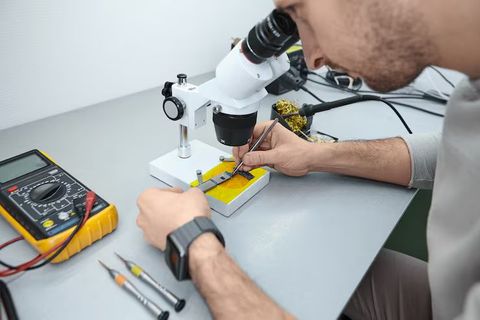The device exists because simply measuring end-to-end light output (with a source and power meter) often won’t reveal where faults, splices or bends are located. An OTDR gives a more detailed view: it can show the location of events (connectors, breaks, splices), the loss at those events, and the overall fibre length.

Importance – why this topic matters today, who it affects, and what problems it solves
Fibre-optic networks are increasingly critical. They form the backbone of internet infrastructure, support high-speed data, 5G backhaul, enterprise links, and long-haul transmission. Ensuring that fibre links are properly installed, maintained and fault-free is vital to network reliability, performance and safety.
For technicians, network operators, deployment teams and maintenance crews, OTDR testers are a key tool. They solve problems such as:
-
Locating a break or flaw in fibre (which might otherwise be very difficult to pinpoint)
-
Verifying splices and connectors are within acceptable loss levels
-
Recording a baseline “snapshot” of the fibre link at installation so future degradation or faults can be compared
-
Certifying or characterising long fibre runs (especially those with many splices, connectors or splitters)
In contexts such as data-centres, metro networks, FTTH (fibre-to-the-home) deployments, and enterprise cabling, having a clear view of fibre health helps reduce downtime, prevent repeated troubleshooting, and support network performance warranty. Also, as fibre networks age or are affected by environmental or mechanical stress, OTDR testing helps detect issues early.
Recent Updates – changes, trends, or news from the past year
Here are some of the recent trends and changes related to OTDR and fibre-optic testing:
-
In 2024 and 2025 there has been increasing emphasis on more advanced OTDR features: higher dynamic range, improved resolution for shorter cables, support for PON networks, and integration of software-based trace analytics.
-
Research in 2025 shows AI-augmented methods are being developed to analyse OTDR traces in noisy environments and assist in fault-localisation (e.g., a 2025 paper introduced a framework combining OTDR signal analysis with machine-learning to classify fibre faults).
-
On the regulatory front in India, the Mandatory Testing & Certification of Telecom Equipment (MTCTE) scheme is evolving: the rules require telecom-equipment certification, including for fibre-optic gear and related systems, affecting how testing equipment may be used or certified.
-
A March/April 2024 blog point: Use of OTDR results alone is not sufficient to certify fibre installations under certain standards (e.g., Telecommunications Industry Association / TIA). It emphasized that OTDR is more of a characterisation/troubleshooting tool rather than the final certification means.
Laws or Policies – how this topic is affected by rules, regulations or government programs
In the Indian context and more broadly:
-
In India, any telecom equipment sold or used must comply with the Telecom Framework to Notify Standards, Conformity Assessment and Certification Rules 2025. Under this, the MTCTE scheme covers mandatory testing and certification of telecom equipment.
-
The rules specify that equipment must be tested at designated labs, certified by the Telecommunication Engineering Centre (TEC), and incorporate certification labels.
-
For optical fibre-cable products, standards such as the Indian/International versions of IS/IEC 60793‑1‑1 specify measurement methods and compliance test procedures.
-
While the OTDR device itself may not be governed as strictly as the fibre-optic link or cable under test, use of standardised procedures (wavelengths, calibration, launch cables) is emphasised in industry documents (for example from Corning Incorporated).
-
It’s important for testing organisations to document the procedures, maintain trace records (in many standards), and ensure that testing meets the criteria defined by the network owner or operating standard. For instance, an industry blog noted that using OTDR alone instead of an insertion-loss tester may not meet certification criteria.
Tools and Resources – helpful tools, apps, websites, templates or services
Here are useful tools and resources for learning about or using OTDR testers:
-
OTDR devices (for example: Exfo FTB‑1 Handheld OTDR, NOYAFA NF‑981 OTDR Tester) which can be used in field testing and are aimed at various budgets.
-
Fibre-optic test-trace analysis software: Many OTDR manufacturers provide software to import/save trace files, compare traces over time, and automate event identification.
-
Qualification standards and white-papers: E.g., “Working principle and characteristics of OTDR” and “Operating principle of an OTDR” help understand how to interpret traces.
-
Test-procedure templates and guidelines: For example, the Corning document providing Tier 1 and Tier 2 testing guidelines for fibre systems and recommendations on launch cables and trace documentation.
-
Online learning and resources: Websites by test-equipment manufacturers (e.g., Fluke, Viavi) have learning centres on OTDR fundamentals.
-
Standards references: For example the IS/IEC series (60793-1-1 etc.) for measurement methods and test procedures in optical fibres.
FAQs – frequently asked questions with clear answers
Q1: What wavelengths are commonly used for OTDR testing?
A: For single-mode fibre links, wavelengths such as 1310 nm and 1550 nm are common because they reflect the operational wavelengths and attenuation characteristics of the fibre.
Q2: Can an OTDR replace a simple light-source/power-meter (insertion-loss) test?
A: No. While an OTDR gives a detailed event map and distances, the total insertion-loss measurement (end-to-end loss) is more accurately measured via a light-source + power-meter (often called OLTS) and is required by many standards for certification.
Q3: What are the “dead zones” in OTDR measurements?
A: The dead-zone is the distance after a strong reflective event (like a connector or fibre end) within which the OTDR cannot accurately detect another event because the receiver is temporarily saturated or recovering. Two types are event dead-zone and attenuation-dead-zone.
Q4: When is OTDR testing most useful?
A: It is particularly useful when:
-
Testing long fibre runs (hundreds of metres or kilometres) with splices and connectors.
-
Troubleshooting faults (breaks, bends, high loss) because you can locate the distance to the event.
-
Capturing a baseline trace at installation so future degradation can be observed.
Q5: What qualifications or settings must I consider when using an OTDR?
A: Important factors include:
-
Choosing proper range, pulse width and wavelength settings to match the fibre length and loss.
-
Using a correct launch cable (sometimes called a pulse-suppressor) at the start of the fibre to allow measurement of the first connection.
-
Ensuring connectors and test jumpers are clean and proper; contamination affects trace quality.
Conclusion
In summary, OTDR testers play a key role in modern fibre-optic networks. They provide a detailed, distance-mapped view of optical links—identifying loss events, locating faults, measuring fibre length and offering trace documentation. While they do not replace simpler insertion-loss tests, they complement them and are indispensable for installation, maintenance and troubleshooting of complex fibre systems. As fibre deployments expand—especially with higher data-rates, 5G and deeper network densification—the importance of proper testing becomes greater. Ensuring you follow industry best-practices, standardised procedures and maintain good records will help keep fibre networks reliable and performant for years to come.








